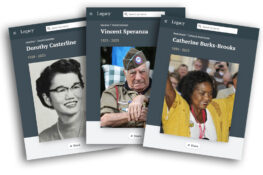Roger Lynds died April 16, 2023, at Brookdale Santa Catalina in Tucson, Arizona. Roger was born on July 28, 1928, in Kirkwood, Missouri. He was the son of Clarence Wiley and Daisy Deene (Foland) Lynds. As a child of a poor family living in the Great Depression, he had many tales of eking out a living with a schoolteacher father, whom he helped to refinish school desks during the summer recess. They often found their only meal of the day to be in a cornfield where they enjoyed fresh ears of corn and a vine-ripe watermelon. Roger would walk the tracks of a nearby railroad looking for chunks of coal that they could use for heating in the winter. When the United States entered WWII, his aunt (in the tradition of Rosie the Riveter) and then his mother (with Roger) moved to Southern California to do war work. His father later joined them. Roger graduated from Glendale High School (California). With encouragement from his father, Roger joined the United States Navy and served on a destroyer-class ship from 1946 to 1948. He took advantage of the GI Bill of Rights in order to attend Glendale College, where he received an Associate of Arts degree in 1950 and a Bachelor of Arts degree from the University of California, Berkeley, in 1952. He continued in graduate school there, specializing in astronomy. He met and married a fellow graduate student, Beverly Ann Turner, in 1954 and they both received their degrees of Doctor of Philosophy, University of California, in 1955. They had one daughter, Susan Elizabeth, born in 1958. They were divorced September 1986. He married Gina Rita Badami on March 22, 1990 (divorced January 29, 2014; died October 15, 2021); they adopted a son, Andrew. Roger remained on as a Research Associate, University of California, Berkeley, from 1955 to 1958, and then received a Canada National Research Council Fellowship at the Dominion Astrophysical Observatory, Victoria, British Columbia, from 1958 to 1959. The National Science Foundation (established in 1950) had recently established a National Radio Astronomy Observatory (NRAO) in Green Bank, West Virginia. Otto Struve, who had been chairman of the astronomy department at the University of California during Roger's time there, accepted the directorship of NRAO and asked Roger to join him on the staff there. Roger served as Assistant Scientist at NRAO from 1959 to 1961. One of the objects studied by Roger was M82. This galaxy was a radio source with a spectrum similar to the Crab Nebula and therefore he concluded that the emission from M82 was due to the synchrotron mechanism and that the synchrotron continuum extended into the optical region (ApJ, v 134, p 659). Roger and Alan Sandage followed up these observations with optical ones (Roger was guest investigator at Lick Observatory) which were reported in their 1963 paper "Evidence for an Explosion in the Center of the Galaxy M82" (ApJ, v 137, p 1005). Roger's primary interest was in optical astronomy and the development of detectors to be used on optical telescopes. In 1961, he joined his friend Bill Livingston on the staff of Kitt Peak National Observatory, Tucson, Arizona, where he stayed until his retirement as Emeritus Astronomer. Livingston and Lynds published several papers on their experiments with electronic image intensifiers (Advances in Electronics and Electron Physics, v 22, p 705-712) and the development of such systems allowed the Kitt Peak 84-inch telescope to compete on equal terms with larger telescopes using traditional photographic detectors. Roger was able to join in the exciting active research on quasi-stellar objects (quasars, or QSOs). For example, in 1971, he wrote "In addition to having the largest redshift (z + 2.877) thus far reported (Lynds and Wills, 1970) the QSO 4C 05.34 is also important because of the character of its absorption-line spectra" (ApJ, v 164, L73-L78). Roger studied these absorption-line spectra in many QSOs and, as described by Geoffrey Burbidge and Adelaide Hewett, "the second system is due simply to the Lyman series of hydrogen lines; it was named the ‘Lyman-alpha forest' by Roger Lynds" (Sky and Telescope, v 88, 6, p 32). On April 27, 1974, Roger was accepted as a member of the National Academy of Sciences. When plans were being made for the Hubble Space Telescope, Jim Westphal invited Roger to join his team in developing and using the Wide Field and Planetary Camera, which became Hubble's workhorse camera for many years. It recorded images through a selection of 48 color filters covering a spectral range from far-ultraviolet to visible and near-infrared wavelengths. Roger was an active member of the team and, as a footnote to history, he was the first to recognize that the Hubble primary mirror suffered from spherical aberration, and so stated at the 10 am meeting on May 20, 1990. However, the group assembled were not predisposed to pay attention to Roger, who got up and delivered a strongly jarring and discordant account. A month later, after an air-tight demonstration of the spherical aberration, the devastating discovery was delivered to the world. Roger's assessment was proven to be correct. Roger continued his interest in ‘strange objects in the universe,' and, in January 1989, he and Vahe Petrosian published a description of a gravitational lens. "We report observations of what appears to be a new class of spatially coherent extragalactic features having, in the two most compelling known examples, the following joint properties: location in clusters of galaxies, narrow arc like shape, enormous apparent length, and situation of center of curvature toward both a type cD galaxy and the apparent center of gravity of the cluster. We present the principal available facts concerning the arcs and briefly discuss a variety of interpretations. The weight of evidence seems to favor the interpretation that these features are images of more distant objects produced by the gravitational field of the intervening clusters." Roger and Vahe continued a long collaboration and in a recent letter Vahe summarizes Roger's research style: His contributions to astronomical research are many, highly regarded and often quoted. Roger's productivity, measured by the number of publications in astronomical journals, will not be very high. However, this is not a true reflection of the importance of his contributions. There are several reasons for this. First, Roger devoted considerable time building state-of-the-art instruments specifically for the "public" observatory at KPNO and for the Hubble Space Telescope. A second reason is because Roger immerses himself in all aspects of a research project starting with hardware development to theoretical modeling and rarely publishes a paper on an incomplete project. He was meticulous in every aspect including in writing papers where he made sure that every word was the correct one and placed properly. Roger was an enthusiastic hiker, enjoying many trips to the Sierras with friends like Bill Livingston, and even more excursions into the Catalina Foothills with other good companions, where he once almost lost his life from a fall over a waterfall! He became a skilled Alpine skier and drove to Santa Fe, New Mexico, a few times a month to ski. For several years he taught skiing at Wolf Creek Ski Area in Colorado. Roger's artistic abilities were most strongly exhibited by his superb calligraphy; as a master craftsman of this art, he was active in the Calligraphic Society of Arizona. Roger also enjoyed classical music and played J. S. Bach enthusiastically on the harpsichord that he had bult and on a more sophisticated one he later purchased. Roger's request was cremation and there will be no services. Roger's ashes will be scattered on his favorite hiking trail in the Catalina Mountains. Memorial donations in Roger's name can be made to one of his favorite online resources—Wikipedia (
https://wikimediafoundation.org/).
Published by Arizona Daily Star from Apr. 18 to Apr. 19, 2023.


















